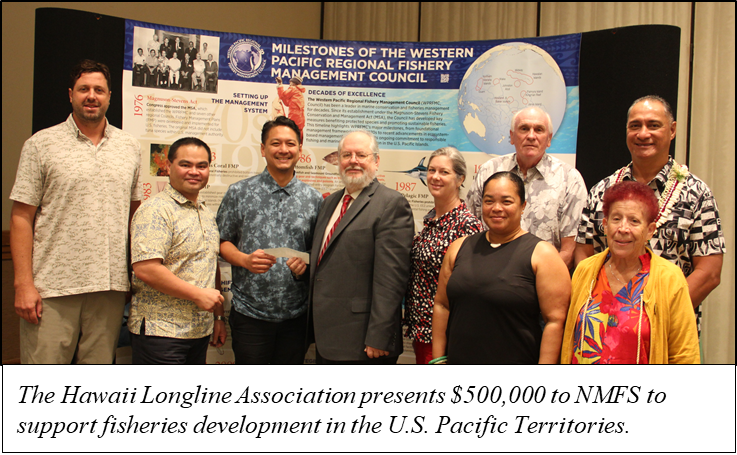News and Announcements
Press Release-Council Receives Praise, Spars with NMFS on Policies (25 September 2024)
 HONOLULU (25 September 2024) Praise from a top federal administrator combined with an airing of interagency issues energized the second session of the Western Pacific Regional Fishery Management Council’s 200th meeting Tuesday.
HONOLULU (25 September 2024) Praise from a top federal administrator combined with an airing of interagency issues energized the second session of the Western Pacific Regional Fishery Management Council’s 200th meeting Tuesday.
Sam Rauch, Deputy Assistant Administrator for Regulatory Programs at the National Marine Fisheries Service (NMFS), opened the session by complimenting the Council for its achievements.
“This Council doesn’t get enough credit for leadership in the region and the example it has set nationally and internationally; things done here echo throughout the world,” said Rauch.
“To name a few,” Rauch continued, “the Council prohibited destructive gears, explosives, poisons; implemented measures on drift gillnets before the drift gillnet act; created areas where industry can thrive and at the same time reduce impacts to protected species; and crafted gear measures with industry that are models for the rest of the world—circle hooks, wire leaders and vessel monitoring systems (VMS).”
The Council welcomed Rauch’s comments, though much of the session focused on policy and procedural disagreements between the Council and NMFS.
Council members expressed frustration with the proposed Endangered Species Act (ESA)-listing of giant clams in the U.S. Pacific Territories. NMFS initiated a status review in 2017 in response to a petition to list 10 species of giant clams under the ESA, but published the proposed rule in July 2024, opening the proposal for a 90-day public comment period. NMFS presenter John Rippe said that for giant clams in general, quantitative data and survey data is very limited.
Council member Sylvian Igisomar questioned if NMFS had considered unpopulated as well as populated areas when gathering information about the giant clams’ spatial distribution.
“I feel NMFS is just ramming this through the system,” said Igisomar, Secretary of the CNMI Department of Lands and Natural Resources. “Some of these species shouldn’t have been [proposed]—just because you can’t access an area, doesn’t mean the clams are not there.”
The Council reiterated its request for NMFS to engage early with local agencies and communities, and to collaborate with the governments of American Samoa, Guam and the CNMI. The members emphasized the importance of working proactively with the U.S. Pacific Territories before considering ESA listings and critical habitat designations.
Council member Chelsa Muña questioned NMFS’s listing of giant clam species as endangered in regions like Guam and the CNMI where those species haven’t been present for many years. “We are working with Palau to reintroduce the species. It’s disconcerting to see the ones that don’t occur in the Marianas on the list since they’re not part of the natural habitat. You will be restricting our ability to repopulate the area,” Muña emphasized.
Members noted that from past experience with other ESA-listed species like turtles, once giant clams are listed, it is difficult to delist them later. Muña said, “If climate change is included as one of the threats, then there is nothing we can really do to change that impact.”
Muña, director of the Guam Department of Agriculture, added this would affect attempts to recover the species, as is the case with several species of corals. “Outplantings require permits, and you can’t outplant corals that are endangered because you have to harvest,” she noted.
Rippe explained that under the ESA, the United States is required to list species based on their status throughout their entire range, not just in certain areas. Though some giant clam species in question don’t occur in the Mariana Archipelago, they exist elsewhere in their range, such as the Great Barrier Reef, the Philippines and Indonesia, which justifies the listing.
American Samoa Council member Archie Soliai added, “For the whole session we heard on ESA and Marine Mammal Protection Act issues, what sticks out the most is ‘restrict, control and prohibit.’ Giant clams are important to our culture, and this inhibits our food security.”
The Council asked NMFS to extend the public comment period to allow more time for agency outreach to affected communities and for community members to comment. It also asked that NMFS work with governments of American Samoa, Guam and the CNMI to review data supporting proposed rules and their socioeconomic and cultural impacts.
The Council sessions at the Ala Moana Hotel Hibiscus Ballroom will conclude Wednesday, Sept. 25.
Western Pacific Regional Fishery Management Council: Secretary of Commerce appointees from nominees selected by American Samoa, the CNMI, Guam and Hawai‘i governors: Will Sword, noncommercial fisherman/engineer (American Samoa) (chair); Roger Dang, Fresh Island Fish Co. (Hawai‘i) (vice chair); Judith Guthertz, University of Guam (Guam) (vice chair); Pete Itibus, noncommercial fisher (CNMI); Shaelene Kamaka‘ala, Hawaiian Islands Land Trust (Hawai‘i); Frank Perez, AC Sales and Service, (Guam); Matt Ramsey, Conservation International (Hawai‘i); and Gene Weaver, Tasi to Table (CNMI). Designated state officials: Dawn Chang, Hawai‘i Dept. of Land & Natural Resources; Sylvan Igisomar, CNMI Dept. of Lands & Natural Resources (vice chair); Chelsa Muña, Guam Dept. of Agriculture; and Archie Soliai, American Samoa Dept. of Marine & Wildlife Resources (vice chair). Designated federal officials (voting): Sarah Malloy, NMFS Pacific Islands Regional Office. Designated federal officials (nonvoting): Colin Brinkman, U.S. State Dept.; Brian Peck, U.S. Fish & Wildlife Service; and RADM Sean Regan, U.S. Coast Guard 14th District.
